Harsh words & violence: A clear link?
Hate speech was treated as part of the wider problem of public order.

The campaigns preceding the Brexit referendum in Britain and Donald Trump’s victory in the US exacted their toll. In both countries insults to and even physical attacks on Muslims and immigrants followed. In December 2015, well before the referendum in Britain and the presidential election in the US, Prof Sara Lipton asked in an incisive article: “Do harsh words lead to violent acts? At the moment when hate speech seems to be proliferating, it is a question worth asking”. Her answer was clear: “Attorney Gen. Loretta E. Lynch recently expressed worry that heated anti-Muslim political rhetoric would spark an increase in attacks against Muslims… history shows that a heightening of rhetoric against a certain group can incite violence against that group, even when no violence is called for...”
Prof. Lipton added: “Today’s purveyors of anti-Muslim, anti-immigrant, anti-police and anti-abortion rhetoric and imagery may not for a moment intend to provoke violence against Muslims, immigrants, police officers and healthcare providers. But in the light of history, they should not be shocked when that violence comes to pass.” The West was slow to act. Hate speech was treated as part of the wider problem of public order. There were legal quibbles about an intention to incite hate and the consequences of hate speech. Britain moved to curb the menace half a century ago, beginning with Race Relations Act, 1965.
Two replacements followed in 1968 and 1976, capped by the Public Order Act, 1986. Section 17 of this act of 1986 defines racial hatred to mean “hatred against any group of persons defined by reference to colour, race, nationality (including citizenship) or ethnic or national origins”. However, as distinguished QCs Geoffrey Robertson and Andrew Nicol pointed out in their work Media Law, prosecutions for violating this law which can be brought “only with the attorney general’s consent, are comparatively infrequent”. The hallowed First Amendment to the US Constitution textually contains no qualification to the right to freedom of speech. But the US Supreme Court has ruled more than once on what it called “group libel” or “fighting words”.
In 1942, the court held in the leading case of Chaplinsky vs New Hampshire: “It is well understood that the right of free speech is not absolute at all times and under all circumstances. There are certain well-defined and narrowly limited classes of speech, the prevention and punishment of which have never been thought to raise any constitutional problem...” A decade later, it reaffirmed this ruling that if “an utterance directed at an individual may be the object of criminal sanctions, we cannot deny to a state power to punish the same utterance directed at a defined group”.
Yet, there is a clear flaw in this reasoning, which makes harm, actual or potential, or the public order, the gist of the offence. But public order means more than the absence of violent conflict. It means the peaceful order of civil society and the dignity of the citizen. Indian law was amended in 1972 by inserting Section 153-B to the Penal Code. It punishes with imprisonment any who “makes… any imputation that any class of persons cannot, by reason of their being members of any religious, racial, language or regional group or caste or community, bear true faith and allegiance to the Constitution of India as by law established or uphold the sovereignty and integrity of India, or asserts…” Its sweep is impressive. Its non-enforcement tells a sorry tale. The remedy lies in removing the fatal flaw of the state’s power to prosecute and invest it in the citizen provided he secures the leave of a high court judge to launch the prosecution.
By arrangement with Dawn

